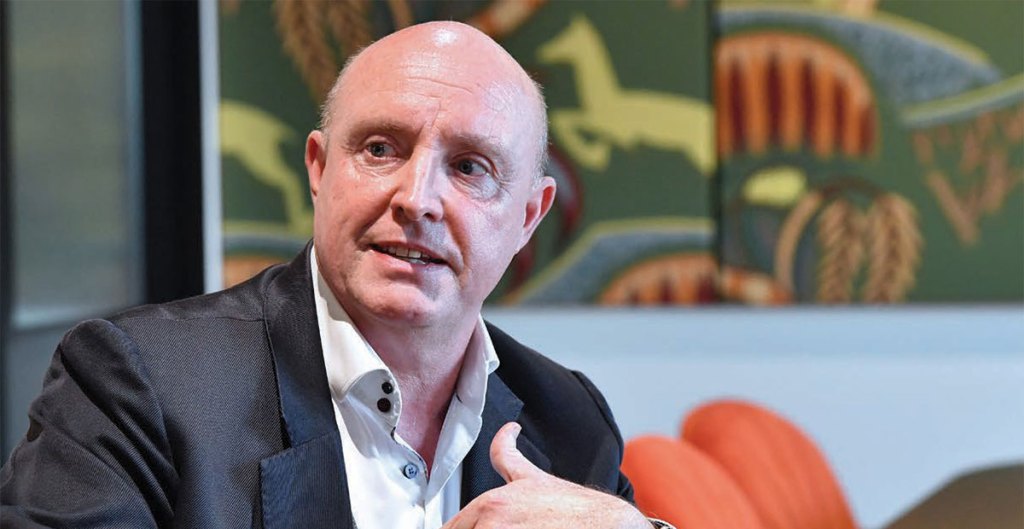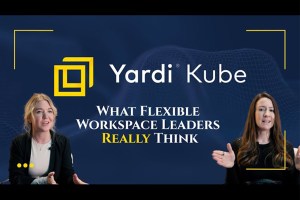Big is Beautiful for the Flexible Workspace Sector
Yardi and Property Week recently brought together a panel of industry experts to discuss the importance of scale in the flexible workspace sector and the challenges operators may face in their quest for growth.

Panel of experts
- Rupert Dean, co-founder and chief executive, x+why
- Rebecca Gardiner, head of Storey, British Land
- Natasha Guerra, chief executive, Runway East
- Justin Harley, regional director, Yardi
- Amanda Lim, partner, flexible office solutions, Knight Frank
- Toby Ogden, chief operating officer, The Office Group
- Andrew Saunders, contributing editor, Property Week (chair)
The booming popularity of flexible workspace with occupiers in particular has made the sector one of the rare bright spots in the office market in recent times. But compared with the traditional leasing model, workspace remains a relatively new product with many small providers – and a few big names – all vying for attention, space and investment.

Why is scale so important? Can’t small be beautiful, too?
Toby Ogden: The Office Group and Fora brands now have about 3.1m sq ft of space across 72 assets post-merger – mainly in London but also the regions, and five buildings in Germany. There are some obvious reasons why scale is an advantage – at a corporate level it’s more efficient, for example, and reduces your operating costs.
At a building level, scale gives you buying power and allows you to have more control over the services that are needed throughout a building, which is really of benefit to us as operators.
But the real reason we did the merger is because of the benefits it brings to our customers. Greater efficiency means we can pass savings on to them, and when their businesses get bigger or smaller or the dynamic changes, we can work harder to keep them by giving them more choice of buildings and locations. For us, scale is choice.
Rebecca Gardiner: Storey is obviously a fairly small part of the British Land portfolio, but the scale of the British Land campuses we are on enables us to deliver operational excellence to our occupiers. That’s because we can use all our British Land contracts from mechanical and electrical to cleaning and property management.
A lot of occupiers make the decision to come with Storey because they understand that it is British Land run. They get access to everything that comes with being part of a British Land campus but they only have to take a two-year lease – or even less.

Natasha Guerra: From a smaller operator’s perspective, scale is about getting access to buildings. As you grow you build a track record of deals and data. Four years ago we never really got invited to tender. Now that we have nine buildings we are doing a lot of tenders where we are pitched against other operators, so that track record really makes a difference.
Rupert Dean: Personally, when I started x+why, I didn’t think about getting lots of properties and going for scale above all else. It was always about that site, that product, that service, those individuals.
But scale is important from an economics point of view because it does spread your central cost base further and improve margins. The other point is that scale gives you a wider funnel – the more buildings you have the more you can capture different people, different sectors and different types of businesses.
What are the challenges faced by operators trying to scale?
Amanda Lim: With scale comes reputation and brand awareness. But you have to make sure you are delivering the right product before you start to scale, because one bad experience can kill a whole brand. We have occupiers who come to us with a list of providers they do not want – even though in my mind they might be great providers – because they have had one bad experience with them.
Dean: Scale is completely pointless if you have a rubbish product, or if it degenerates because of scale. So keeping your DNA is fundamental, and my job as chief executive is to maintain that DNA so that scale does not come at the expense of our product. It helps that x+why is purpose driven so it’s pretty clear to everyone in the business what we are trying to achieve.
Guerra: As we’ve grown, we’ve found that consistency is the hardest thing to scale. And that it gets more expensive before it gets cheaper – we actually need to increase our cost base to get consistency across our buildings. It’s much easier to be consistent when you have a small management team and you can walk between all your buildings than it is when you are in multiple regions and you are sheltered from the frontline.
“As we’ve grown, we’ve found that consistency is the hardest thing to scale. And that it gets more expensive before it gets cheaper.”
Natasha Guerra, chief executive, Runway East
The challenge of getting from 10 buildings to 20 is that the capital required is quite high – you need more sophisticated management, more sophisticated data and more sophisticated tech, and that is all quite expensive.
Justin Harley: I am a customer, and I am also a provider of systems that help people scale. There are some easy wins that workspace operators don’t always get right – booking meeting rooms, for example. I want to be able to do that on an app on the evening before I need the room, not have to email someone a few days earlier. I am not always organised enough to remember to do that.
Scale is also about having the right people with the right skills in the right places, not just on the front desk. People like project managers and data analysts who work in the core of the business to make scale happen.
What are the pros and cons of management agreements between building owners and workspace operators when it comes to scaling more quickly?

Ogden: We own buildings, we manage buildings and we lease buildings – we don’t have a preferred model; it’s about what is right for a particular building. But management agreements are a big part of the future for us – the older model of traditional leasing has a declining share of occupier demand.
One of the things that is different about a management agreement [compared with leasing] is that it aligns the interests of the owner who controls the real estate with the occupational experience of the customer.
So if something goes wrong with the lift, or the toilets, the person the customer is engaging with actually controls the ability to fix the problem. You don’t get that situation where a problem that is controlled by the landlord is perceived by the customer as being the operator’s responsibility.
“Despite all the headlines, AI won’t mean that you don’t need people anymore but it will mean that you will need a very different set of skills and staffing structure.”
Justin Harley
Dean: Management agreements are all we do. Compared with the market five years ago, there is a unique set of circumstances around them at present: high interest rates, a declining leasing model and a lot of debt.
There is less trading happening so the market is more about holding assets for the longer term than the old mindset of ‘develop, fill, flip and go again’. That makes management agreements far more interesting because they can look five, 10 or – in the case of organisations like Portman Estates – even 50 years into the future.
Management agreements also mean that we can create a single operator model throughout a whole building, rather than having to engage multiple stakeholders. The service we provide becomes much more like a hotel – you pick up the phone, press a button and someone helps you immediately. Management agreements are better from both an operator point of view and a governance point of view.
How much of a hindrance are issues around how to value workspace assets?

Lim: We get a lot of questions about valuations, particularly from owners who would like to go down the management agreement route but who want to know how that will affect the value of their building. There aren’t many valuers who can [value workspace assets]. You can value a hotel where people only book in for a night, but not a workspace.
Gardiner: For Storey currently, valuation is an issue but not a big one, because [for British Land as a whole] it’s a small percentage of the cashflow coming in on every building. Valuations are partly transaction led, and at the moment there is nothing transacting, so there is no evidence from a valuer’s perspective. Until the wider market gets moving, that’s going to remain difficult. But we are a big voice in the market and we will keep pressuring the valuers.
Ogden: Demand from customers [for flexible space] is going to outstrip all the legacy parts of the industry in future, including the way valuations are attributed. That demand will drive the change.
Are hybrid working patterns now established or are occupiers’ needs still in flux?
Guerra: We are not yet at a stabilised point – many customers don’t really know how much time their people will be spending at home versus in the office. That has been great for the sector because so many large occupiers have moved to taking flex space.
Gardiner: Looking at our occupiers at 100 Liverpool Street, they are generally big businesses who would previously have had a lot of space under a traditional lease. Now they say “actually we only need a third as many desks as we did”, but they want the flexibility to respond to changing working patterns so they are able to take more space with us.
I also think many occupiers will get used to not requiring their own facilities management teams, for example.
Ogden: The reality is that businesses are starting to outsource their workplace experience, and I believe that in future that will be the relevant point, not flexibility. We should be trying to create a better experience across the office sector, whether that’s for 10 years or 12 months.
Will the rise of artificial intelligence (AI) kill demand for physical workspace?

Harley: We are still slightly old-fashioned in the way we do things in this industry, and AI is going to change things massively. In 10 years’ time, AI will be answering many of the questions that are currently answered by people on phones, for example. That will help drive consistency and scale, and it will make real estate as a whole much more efficient.
Despite all the headlines, AI won’t mean that you don’t need people anymore, but it will mean that you will need a very different set of skills and staffing structure.
Gardiner: All of us in this room believe in the value of offices and what coming to work brings us. And I believe that in 10 years’ time, when AI is doing so many things, people will still want to come to the office because we are human beings and we want social interaction at work.
The challenge in a market where there are so many operators is to keep moving with the times. What’s the product, what market are you going after and how do you keep evolving without getting distracted by every new shiny thing?
Lim: Fundamentally, it’s about the experience. People don’t just choose offices because of the bricks and mortar and the location, but also because of the experience – the way an office makes someone feel. AI can perhaps assist in that, but it can’t actually deliver the experience.
First published on Property Week.
Follow Yardi Kube on LinkedIn for the latest news, customer stories and blog posts.




